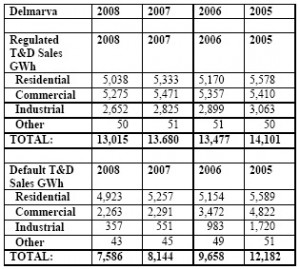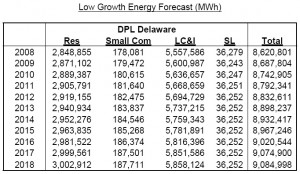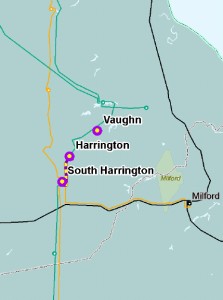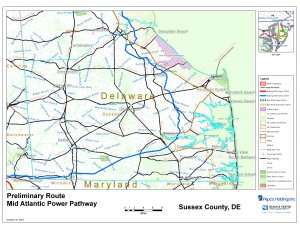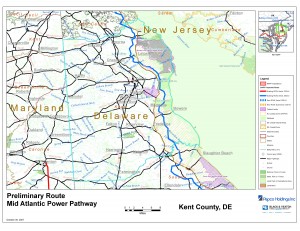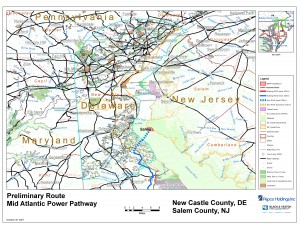Delmarva Power IRP Tomorrow Night!
July 13th, 2009
That’s Idiocy Returning on Parade…
Tomorrow night in Dover, the Public Service Commission is opening the doors and it’s your turn to let them know what you think about Delmarva Power’s energy policy, how they’re getting their electricity, what sort of generation it’s coming from, what they’re doing (not) about conservation and efficiency, and what sort of generation you want them to use, i.e., get wind on line NOW! And tell them we don’t need no stinkin’ transmission!
This is your opportunity. They won’t let parties testify, so it’s your turn to step up to the plate.
Now for some background. All the PSC blurbs call this the 3rd Delmarva Power IRP, but it’s not, it’s their third attempt to get it right, and the last one was so bad that they spent years trying and last November submitted a redo as asked by PSC, then a month later, they send a lame cover letter saying that they want to count that November redo attempt as the one due December 1, 2008.
So the PSC grabs that November 2008 attempt and accepts it. EH???
Right… whatever.
You might remember Delmarva Power’s Todd Goodman’s outrageous behavior at the last IRP meeting in December, 2008. AWARD FOR TODD GOODMAN, DELMARVA POWER.
Well, the Delmarva Power IRP saga continues, and the Workshop, Public Comment session…. whatever it is, it’s tomorrow night.
Tell the PSC that it’s time Delmarva Power get serious about conservation, that we want coal plants shut down, that it’s time to get wind on line, and that we do NOT want the Mid-Atlantic Power Pathway transmission line (you know, that line that runs from coal plants SW of Delaware, up through Indian River and to Salem. PJM admits that the Indian River to Salem part of it is not needed, and it’s time to get the WHOLE truth out, that the entire line is not needed. See Mid-Atlantic MAPP line cut short).
COME TO THE PSC’S DELMARVA POWER IRP WORKSHOP… PUBLIC COMMENT SESSION… JUST COME AND TELL THEM WHAT YOU THINK?
ruth.price@state.de.us
Delmarva Power’s IRP is based on an annual increase in demand of 1.9%. Uh-huh… right…
Look what has been happening to electrical use:
Hmmmmmmmmmm, do you see what I seeeeeeeeeeeeee…
Regulated T&D Sales have gone down.
Default T&D Sales have taken a significant dive.
Despite that, what do they project in the IRP? From their IRP Appendix A:
Energy use, measured in MWh, has been dropping significantly for years… but we knew that…
Now what about peak? The Delmarva peak isn’t in their 10-Ks, but here’s PJM:
2008 Peak 136,310MW
Projected Peak 134,430MW
DOWN 1,880MW
DOWN 1.4%
And with 165,200MW of generation and a reserve margin of 28.6% (15% necessary) which even PJM describes as “well in excess,” suffice it to say PJM doesn’t need new power anytime soon.
Read it all here:
And here’s some history – PJM’s revenue decreased 8% in 2008 (p. 9 of 44):
And remember, PEPCO, Delmarva Power’s parent, says that it may not sell shares to finance the MAPP line — so how would they finance it… or would they just admit that it’s not needed and not build it?
Pepco CFO May Postpone Investment to Avoid Share Sale
Pepco fell 3 cents to $13.39 in composite trading on the New York Stock Exchange.
Mid-Atlantic’s MAPP line cut short
May 20th, 2009
PJM, Delmarva Power, PEPCO, PHI, whatever, admit that demand is down and that the Mid-Atlantic Power Pathway, the transmission line through Maryland and Delaware to New Jersey, should be delayed
The Mid-Atlantic Power Pathway, or MAPP, is part of PJM’s “Project Mountaineer,” a web of lines expressly designed to move coal generation from the Amos plant in West Virginia and gather other coal and nuclear generation and send it in a northeasterly direction:
See the MAPP line there in the NE section of Project Mountaineer line 4?
PJM has recommended delay of the inservice date for a portion of the MAPP line by a year, the portion from Indian River to Salem nuclear plant. What remains, however, is a problem, because electrically, it makes no sense to build a 500kV radial line to nowhere. If part of the line should be delayed, the ENTIRE line should be delayed.
Here’s the corporate Press Release and two “articles” which should be compared!
Press Release from Delmarva site
MAPP: Controversial High Voltage Electric Transmission Line Delayed for One Year
PJM Reinforces MAPP Need: Adds Year to Schedule (states “contributed by Delmarva Power”)
This demonstration of lack of need is something that should be raised in the Delmarva Power IRP docket, that demand is down so significantly that PJM thinks infrastructure construction should be delayed. And yes, PJM demand is way, way down.
So, since demand is so far down, this is a good time to let the PSC know, in the Delmarva Power IRP docket, that we know that demand is down, so far down that they can’t cover anymore and they have to postpone some of their infrastructure construction. The Hearing Officer is taking public comments on the Delmarva Power IRP until some time in July, I think the 25th.
Send IRP Public Comments to the Hearing Eximaner Ruth Price:
What’s an IRP Comment? The Integrated Resource Planning process is supposed to be the way a utility plans ahead to cover their demand, and it’s essentially the intersection of energy policy and those #(%&*)#*( utilities. This is the arena where it’s determined whether they should meet their demand through conservation (the cheapest and environmentally the smallest footprint), efficiency steps like load shifting and SmartGrid, offshore wind paired with natural gas for backup, and whether external costs of various generation options are taken into account. SOOOOO, does that give you an idea of what’s up?
See Delmarva Power’s IRP docket at the PSC, scroll down beyond that rulemaking on the top:
And note this sly trick — they couldn’t get their IRP right from last cycle and were told by PSC staff to take it home and try again, and the last revision of that last IRP is the one they submitted:
And they said in their accompanying letter that this one should be for THIS cycle! AAAAAAARGH!
So, it’s time to review this joke of an IRP, take a look at PJM load forecasting, look at PJM and PEPCO SEC filings like their 2008 10-K and 2009 1st Quarter 10-Q:
Dig up some good conservation reports and sent them in as examples of what can be done. Let them know that with PJM demand down, we expect some changes, that this is a good opportunity to take a sustainable fork in the road, when demand is down we can make conscious choices.
Once more with feeling, check out the Delmarva Power IRP and send comments to ruth.price@state.de.us.
Sussex meeting on Delmarva Power/PEPCO’s Mid-Atlantic Power Pathway
February 9th, 2009
We’re stuck here in Minnesota for a while, parental health issues to deal with, and thankfully others have posted on the meeting this week in Delaware about the Mid-Atlantic Power Pathway proposed by Delmarva and PEPCO.
His post shows that it’s the same everywhere — coffee & cookies and 20 utility employees to “explain.” TWENTY!
From his blog — does this scene look familiar:
AND knowing that 600 showed up in Maryland, that there’s lots of interest, he notes that there were only 30 chairs. Come on, PEPCO, that is SO tacky…
This project is part of something much bigger…
Here’s my post on RTEP – Regional Transmission Expansion Plan
Here’s some info about their plan, the original proposal, and info about AC v. DC lines, focused on the submarine cable for the Chesapeake Bay:
FERC has approved a Return on Investment of 12.8%:
The June 12 PowerPoint says it will cost $1.5 billion, and the FERC press release says $1.05 billion. Slip of the decimal?
Take a look at their Market Efficiency Analysis — projections of cost and revenue changes:
In short, here’s what this line is about:
I found a powerpoint with some of the upgrades planned:
Here are maps to some Delaware projects from this September powerpoint:
600 show up for Delmarva Power transmission line meeting
February 6th, 2009
WOW! “Nearly 600” show up for a meeting about transmission. Good, Delmarva deserves that kind of response for their threat to ram the Mid-Atlantic Power Pathway transmission line through Maryland and Delaware to New Jersey. They’re so desperate that they’re threatening “rolling blackouts:”
More transmission lies. WDMT caught them making the same threats:
Delmarva Power Community and Communications Coordinator Matt Likovich said, “There have been projections that if we don’t do something to improve our infrastructure… we could be faced with rolling blackouts by the year 2011.”
Threatening rolling blackouts, saying that’ll happen by 2011, so we need to build this line by 2013… yeah… sure… whatever… Get a grip, guys, we are not that stupid, we’re not buying your threats — it is SO naughty to do that.
Power lines would relieve congestion
Sussex Co. transmission meeting tonight
February 4th, 2009
Tonight is the final meeting in the group scheduled by Delmarva Power about the Mid-Atlantic Power Pathway, transmission through Delaware to New Jersey.
Wednesday, February 4 @ 6 p.m.
Millsboro Civic Center
322 Wilson Highway
Millsboro, Delaware
Sussex County:
Kent County:
New Castle County (cutout):
For more info on the underlying scheme, see my prior post:
